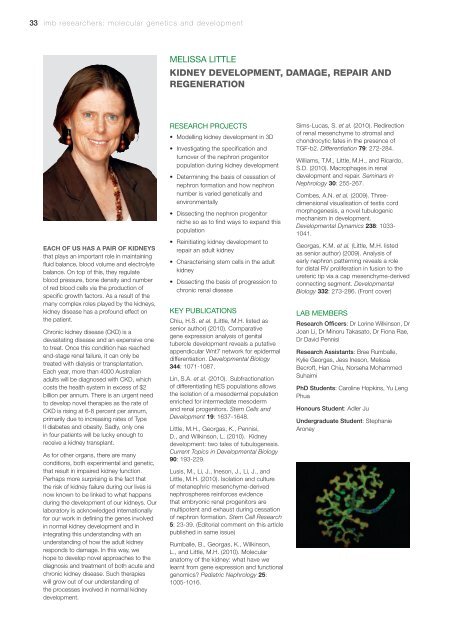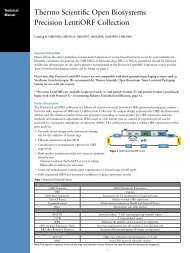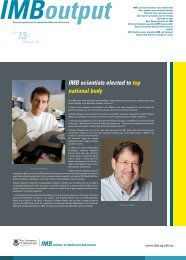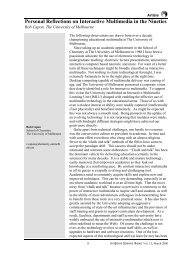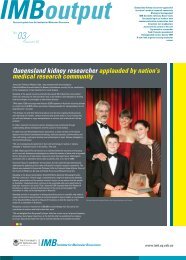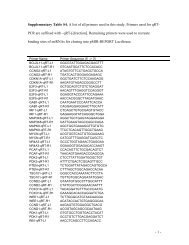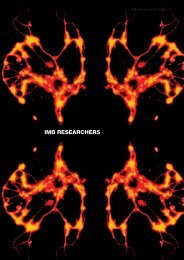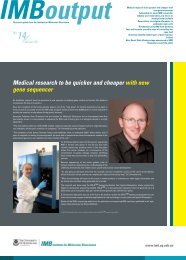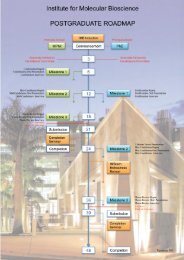2010 Annual Report - Institute for Molecular Bioscience - University ...
2010 Annual Report - Institute for Molecular Bioscience - University ...
2010 Annual Report - Institute for Molecular Bioscience - University ...
You also want an ePaper? Increase the reach of your titles
YUMPU automatically turns print PDFs into web optimized ePapers that Google loves.
33 imb researchers: molecular genetics and development<br />
MELISSA LITTLE<br />
KIDNEY DEVELOPMENT, DAMAGE, REPAIR AND<br />
REGENERATION<br />
EACH OF US HAS A PAIR OF KIDNEYS<br />
that plays an important role in maintaining<br />
fluid balance, blood volume and electrolyte<br />
balance. On top of this, they regulate<br />
blood pressure, bone density and number<br />
of red blood cells via the production of<br />
specific growth factors. As a result of the<br />
many complex roles played by the kidneys,<br />
kidney disease has a profound effect on<br />
the patient.<br />
Chronic kidney disease (CKD) is a<br />
devastating disease and an expensive one<br />
to treat. Once this condition has reached<br />
end-stage renal failure, it can only be<br />
treated with dialysis or transplantation.<br />
Each year, more than 4000 Australian<br />
adults will be diagnosed with CKD, which<br />
costs the health system in excess of $2<br />
billion per annum. There is an urgent need<br />
to develop novel therapies as the rate of<br />
CKD is rising at 6-8 percent per annum,<br />
primarily due to increasing rates of Type<br />
II diabetes and obesity. Sadly, only one<br />
in four patients will be lucky enough to<br />
receive a kidney transplant.<br />
As <strong>for</strong> other organs, there are many<br />
conditions, both experimental and genetic,<br />
that result in impaired kidney function.<br />
Perhaps more surprising is the fact that<br />
the risk of kidney failure during our lives is<br />
now known to be linked to what happens<br />
during the development of our kidneys. Our<br />
laboratory is acknowledged internationally<br />
<strong>for</strong> our work in defining the genes involved<br />
in normal kidney development and in<br />
integrating this understanding with an<br />
understanding of how the adult kidney<br />
responds to damage. In this way, we<br />
hope to develop novel approaches to the<br />
diagnosis and treatment of both acute and<br />
chronic kidney disease. Such therapies<br />
will grow out of our understanding of<br />
the processes involved in normal kidney<br />
development.<br />
RESEARCH PROJECTS<br />
• Modelling kidney development in 3D<br />
• Investigating the specification and<br />
turnover of the nephron progenitor<br />
population during kidney development<br />
• Determining the basis of cessation of<br />
nephron <strong>for</strong>mation and how nephron<br />
number is varied genetically and<br />
environmentally<br />
• Dissecting the nephron progenitor<br />
niche so as to find ways to expand this<br />
population<br />
• Reinitiating kidney development to<br />
repair an adult kidney<br />
• Characterising stem cells in the adult<br />
kidney<br />
• Dissecting the basis of progression to<br />
chronic renal disease<br />
KEY PUBLICATIONS<br />
Chiu, H.S. et al. (Little, M.H. listed as<br />
senior author) (<strong>2010</strong>). Comparative<br />
gene expression analysis of genital<br />
tubercle development reveals a putative<br />
appendicular Wnt7 network <strong>for</strong> epidermal<br />
differentiation. Developmental Biology<br />
344: 1071-1087.<br />
Lin, S.A. et al. (<strong>2010</strong>). Subfractionation<br />
of differentiating hES populations allows<br />
the isolation of a mesodermal population<br />
enriched <strong>for</strong> intermediate mesoderm<br />
and renal progenitors. Stem Cells and<br />
Development 19: 1637-1648.<br />
Little, M.H., Georgas, K., Pennisi,<br />
D., and Wilkinson, L. (<strong>2010</strong>). Kidney<br />
development: two tales of tubulogenesis.<br />
Current Topics in Developmental Biology<br />
90: 193-229.<br />
Lusis, M., Li, J., Ineson, J., Li, J., and<br />
Little, M.H. (<strong>2010</strong>). Isolation and culture<br />
of metanephric mesenchyme-derived<br />
nephrospheres rein<strong>for</strong>ces evidence<br />
that embryonic renal progenitors are<br />
multipotent and exhaust during cessation<br />
of nephron <strong>for</strong>mation. Stem Cell Research<br />
5: 23-39. (Editorial comment on this article<br />
published in same issue)<br />
Rumballe, B., Georgas, K., Wilkinson,<br />
L., and Little, M.H. (<strong>2010</strong>). <strong>Molecular</strong><br />
anatomy of the kidney: what have we<br />
learnt from gene expression and functional<br />
genomics Pediatric Nephrology 25:<br />
1005-1016.<br />
Sims-Lucas, S. et al. (<strong>2010</strong>). Redirection<br />
of renal mesenchyme to stromal and<br />
chondrocytic fates in the presence of<br />
TGF-b2. Differentiation 79: 272-284.<br />
Williams, T.M., Little, M.H., and Ricardo,<br />
S.D. (<strong>2010</strong>). Macrophages in renal<br />
development and repair. Seminars in<br />
Nephrology 30: 255-267.<br />
Combes, A.N. et al. (2009). Threedimensional<br />
visualisation of testis cord<br />
morphogenesis, a novel tubulogenic<br />
mechanism in development.<br />
Developmental Dynamics 238: 1033-<br />
1041.<br />
Georgas, K.M. et al. (Little, M.H. listed<br />
as senior author) (2009). Analysis of<br />
early nephron patterning reveals a role<br />
<strong>for</strong> distal RV proliferation in fusion to the<br />
ureteric tip via a cap mesenchyme-derived<br />
connecting segment. Developmental<br />
Biology 332: 273-286. (Front cover)<br />
LAB MEMBERS<br />
Research Officers: Dr Lorine Wilkinson, Dr<br />
Joan Li, Dr Minoru Takasato, Dr Fiona Rae,<br />
Dr David Pennisi<br />
Research Assistants: Bree Rumballe,<br />
Kylie Georgas, Jess Ineson, Melissa<br />
Becroft, Han Chiu, Norseha Mohammed<br />
Suhaimi<br />
PhD Students: Caroline Hopkins, Yu Leng<br />
Phua<br />
Honours Student: Adler Ju<br />
Undergraduate Student: Stephanie<br />
Aroney


